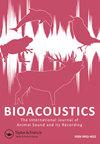Slope does not affect autonomous recorder detection shape: considerations for acoustic monitoring in forested landscapes
IF 2.1
4区 生物学
Q2 ZOOLOGY
Bioacoustics-The International Journal of Animal Sound and Its Recording
Pub Date : 2021-05-27
DOI:10.1080/09524622.2021.1925590
引用次数: 5
Abstract
ABSTRACT To date, there are no published guidelines on how to optimally install recorders on sloped terrain, although slope could potentially affect a recorder’s detection space. This study experimentally investigated the effect of microphone orientation in relation to slope of recorders from two cost classes. We installed four recorders at each plot centre (n = 16), oriented either parallel or perpendicular to the slope. We played standard tones of 1–11 kHz at distances of 10, 20, 40 and 80 m from the recorders. Our two response variables were the presence/absence of each tone (coarse spatial scale) and predicted sound extinction distance (fine spatial scale), which were tested for effects of microphone orientation and sound source direction (SSD). We observed a significant effect of microphone orientation on extinction distance when recorders were perpendicular to the slope at the finer spatial scale as an interaction with SSD, indicating that microphones are biased towards the direction they face. Despite the advertised directionality of most recorder microphones, detection space is not circular. This trend was observed across all frequencies, for both high- and low-cost recorders. Microphone orientation in relation to slope is not an important methodological consideration, instead dominant factors such as frequency and prevailing wind direction drive detection space shape.坡度不影响自动记录仪探测形状:森林景观中声学监测的考虑
摘要到目前为止,还没有关于如何在斜坡地形上最佳安装记录仪的公开指南,尽管斜坡可能会影响记录仪的检测空间。这项研究从两个成本类别中实验研究了麦克风方向与记录器斜率的关系。我们在每个绘图中心(n=16)安装了四个记录仪,方向与斜坡平行或垂直。我们在距离录音机10米、20米、40米和80米的地方播放了1–11 kHz的标准音调。我们的两个响应变量是每个音调的存在/不存在(粗略空间尺度)和预测的消声距离(精细空间尺度),并测试了麦克风方向和声源方向(SSD)的影响。当记录器在更精细的空间尺度上垂直于斜坡时,我们观察到麦克风方向对消光距离的显著影响,这表明麦克风偏向于它们所面对的方向。尽管大多数录音机麦克风的方向性广为宣传,但检测空间并不是圆形的。对于高成本和低成本记录器,在所有频率上都观察到了这种趋势。与斜率相关的麦克风方向不是一个重要的方法考虑因素,而是主要因素,如频率和主导风向驱动检测空间形状。
本文章由计算机程序翻译,如有差异,请以英文原文为准。
求助全文
约1分钟内获得全文
求助全文
来源期刊
CiteScore
4.50
自引率
0.00%
发文量
25
审稿时长
>12 weeks
期刊介绍:
Bioacoustics primarily publishes high-quality original research papers and reviews on sound communication in birds, mammals, amphibians, reptiles, fish, insects and other invertebrates, including the following topics :
-Communication and related behaviour-
Sound production-
Hearing-
Ontogeny and learning-
Bioacoustics in taxonomy and systematics-
Impacts of noise-
Bioacoustics in environmental monitoring-
Identification techniques and applications-
Recording and analysis-
Equipment and techniques-
Ultrasound and infrasound-
Underwater sound-
Bioacoustical sound structures, patterns, variation and repertoires

 求助内容:
求助内容: 应助结果提醒方式:
应助结果提醒方式:


